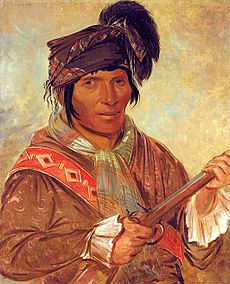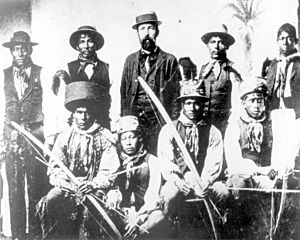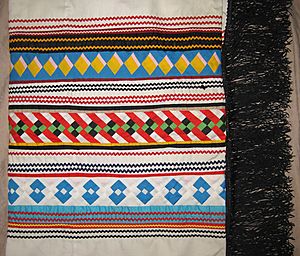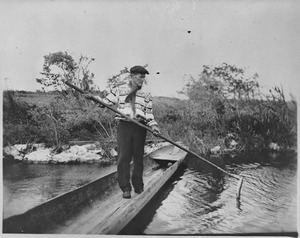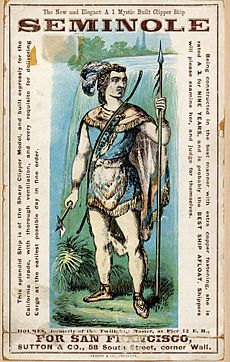Seminole facts for kids
| yat'siminoli | |
|---|---|
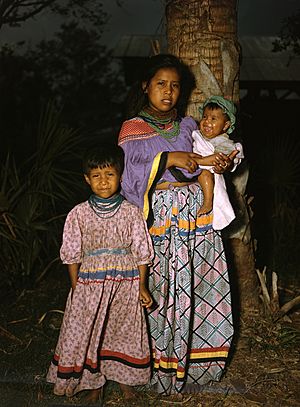
A Seminole mother and her children from the Brighton Reservation in Florida. (1948)
|
|
| Total population | |
| est. 18,600 Seminole Nation of Oklahoma 15,572 enrolled Seminole Tribe of Florida 4,000 enrolled Miccosukee Tribe of Indians of Florida 400 enrolled |
|
| Regions with significant populations | |
| United States ( |
|
| Languages | |
| Main: English Cultural: Mikasuki, Muscogee, Afro-Seminole Creole Historical: Spanish |
|
| Religion | |
| Protestant, Catholic, Green Corn Ceremony | |
| Related ethnic groups | |
| Ethnic origin: Choctaw, Muscogee, Yamasee, Yuchi, Gullah Subgroup: Black Seminole, Miccosukee, Mascogos |
The Seminoles are a Native American people. They first formed in Florida during the 1700s. Today, Seminoles live in Oklahoma and Florida. There are three main groups recognized by the government: the Seminole Nation of Oklahoma, the Seminole Tribe of Florida, and the Miccosukee Tribe of Indians of Florida. There are also other independent Seminole groups. The Seminole people came from different Native American groups. These groups settled in Spanish Florida starting in the early 1700s. Many were Muscogee Creeks from what is now Georgia and Alabama.
In the mid-1900s, old Seminole crafts and traditions became popular again. This happened as Seminoles in Florida and Oklahoma started to welcome tourists. In the 1970s, Seminole tribes began running small bingo games on their lands. They won legal cases to start Indian gaming on their own land. Many tribes in the U.S. now use gaming to earn money for things like education and community projects.
The Seminole Tribe of Florida has been very successful with gaming. This is because many tourists visit Florida. In 2007, they bought the Hard Rock Café company. They have opened many casinos and resorts under that name. Two large resorts on their Tampa and Hollywood lands cost over a billion dollars to build.
Contents
What Does "Seminole" Mean?
The name "Seminole" likely comes from the Creek word simanó-li. This word means "frontiersman," "outcast," or "runaway." It might also come from the Spanish word cimarrón, meaning "runaway" or "wild one." This Spanish word was used for some Native American groups in Florida long ago.
The people who first formed the Seminole group either chose to leave their old tribes or were asked to leave. The Seminoles call themselves yat'siminoli, which means "free people." This is because their ancestors successfully fought against being controlled or forced to change their religion for many centuries. They signed several agreements with the U.S. government, like the Treaty of Moultrie Creek and the Treaty of Paynes Landing.
Seminole Culture and Traditions
Seminole culture is mostly based on the Creek culture. One important tradition they kept is the Green Corn Dance ceremony. Other traditions include using the black drink and special tobacco in rituals. As Seminoles lived in Florida, they created new local traditions. For example, they built open-air houses with thatched roofs called chickees. In the past, Seminoles spoke Mikasuki and Creek. Both are Muskogean languages.
Seminole History
Early Origins in Florida
Before Europeans arrived in the early 1500s, Florida was home to many Native cultures. But new diseases from Europe and fights with Spanish settlers caused a huge drop in Florida's native population. By the early 1700s, much of Florida was empty. Only towns like St. Augustine and Pensacola remained.
Around this time, many Muscogee Creek people started moving into Florida. They were escaping conflicts with English settlers to the north. They built towns mainly in the Florida panhandle. Other Native American refugees, like the Yuchi and Yamasee, also moved to Spanish Florida in the early 1700s. More arrived later in the 1700s. These were Lower Creeks who moved from their towns to avoid the Upper Creeks and settlers from the Province of Carolina. They mostly spoke Hitchiti, which is a dialect of Mikasuki. Mikasuki is the main traditional language spoken today by the Miccosukee in Florida. Also, African Americans who had escaped slavery in the Southern Colonies found safety in Florida.
The new arrivals settled in lands that were once home to groups like the Apalachee, Timucua, and Calusa. These native groups had been greatly reduced by diseases from Spanish explorers. Later, raids by settlers from Carolina and Native American slave traders destroyed the Spanish missions in northern Florida. Most survivors left for Cuba when Spain gave Florida to the British in 1763.
Forming the Seminole Identity (1700s-1800s)
As different groups settled in Florida during the 1700s, they mixed with each other and with the few remaining native people. They created a new culture and called themselves "Seminole." This name came from a Creek word meaning "wild" or "runaway." The Seminoles were a mix of people, mostly Lower Creeks from Georgia. By the time of the Creek War (1813–1814), there were about 4,000 Seminoles in Florida. Many refugees from the Red Sticks group joined them, adding about 2,000 more people. These were Creek-speaking Muscogee people.
A few hundred African Americans who had escaped slavery also settled near Seminole towns. They became known as the Black Seminoles. They kept many parts of their own Gullah culture. The Seminoles spoke two languages: Creek and Mikasuki. Creek became the main language for important discussions.
The Seminoles became more independent from other Creek groups. They built their own identity. They developed a strong trading network during the British and Spanish periods (1767–1821). The tribe grew a lot during this time. More escaped slaves from Southern plantations joined them. These people settled near Seminole towns and paid tribute to them.
During the colonial years, the Seminoles got along well with both the Spanish and the British. In 1784, after the American Revolutionary War, Britain gave Florida back to Spain. The Spanish Empire was getting weaker, which allowed the Seminoles to settle deeper into Florida. They were led by chiefs from the Alachua area. Micanopy was the main chief of the Seminoles from 1825 until he died in 1849.
After some attacks by Anglo-American settlers in the mid-1700s, the Seminoles fought back. They raided the Southern Colonies, especially Georgia. The Seminoles also welcomed escaped slaves from Southern plantations. This made slave owners in the American South very angry.
After the United States became independent, the U.S. Army and local groups often entered Spanish Florida. They wanted to capture escaped slaves living among the Seminoles. American general Andrew Jackson's campaign against the Seminoles in 1817–1818 was called the First Seminole War. Even though Spain protested, the United States effectively controlled the Florida panhandle after this war.
The Seminole Wars
In 1819, the United States and Spain signed a treaty. The U.S. got Florida. President Andrew Jackson became Florida's military governor. As more European Americans moved into Florida, they wanted Native Americans removed from the land. Slave owners were angry that tribes protected escaped African Americans. More settlers also wanted the land held by Native Americans.
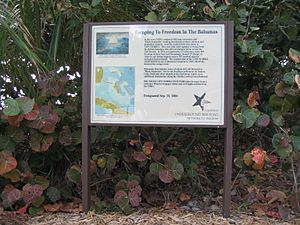
After the U.S. got Florida in 1821, many American slaves and Black Seminoles often escaped from Cape Florida to the British colony of the Bahamas. They mostly settled on Andros Island. Records show 120 people escaped in 1821, and 300 more in 1823. They were picked up by Bahamians in boats. They created a village called Red Bays on Andros.
Under pressure from settlers, the U.S. government made the 1823 Treaty of Camp Moultrie with the Seminoles. They took 24 million acres in northern Florida. They offered the Seminoles a much smaller reservation in the Everglades. The Seminoles and Black Seminoles moved into central and southern Florida.
In 1832, the U.S. government signed the Treaty of Payne's Landing with a few Seminole chiefs. This treaty promised lands west of the Mississippi River if the chiefs agreed to leave Florida. But many Seminoles who stayed prepared for war. White settlers kept pushing for their removal.
In 1835, the U.S. Army arrived to make the treaty happen. The Seminole leader Osceola led the fight against them. The Seminoles had about 4,000 people and 800 allied Black Seminoles. They had at most 1,400 warriors. They fought against U.S. Army and militia forces that had 6,000 to 9,000 troops. To survive, the Seminoles used guerrilla tactics. They knew how to move through the Everglades and use it for protection. Osceola was arrested in 1837 when he came to talk under a flag of truce. He died in jail less than a year later.
Other war chiefs, like Halleck Tustenuggee and John Jumper, and Black Seminoles Abraham and John Horse, continued fighting. The war ended in 1842 after ten years. The U.S. government spent about $40,000,000 on the war. About 3,000 Seminoles and 800 Black Seminoles were forced to move to Indian Territory (now Oklahoma). They were settled on the Creek reservation. After more fights in the Third Seminole War (1855-1858), about 200 survivors went deep into the Everglades. They were finally left alone and never surrendered.
The Florida Seminoles say they are the only tribe in America never to have signed a peace treaty with the U.S. government.
Seminoles During the American Civil War
During the American Civil War, the Confederate government of Florida tried to get the Seminoles to fight for them. But the Seminoles remained neutral. They did not officially pick a side. Some Seminole leaders, like Halleck Tustenuggee and Sonuk Mikko (Billy Bowlegs), refused to sign agreements with the Confederacy. They joined with the Union.
After the war, the U.S. government said all old treaties with the Oklahoma Seminoles were no longer valid. This was because some had allied with the Confederacy. New peace treaties were needed. These treaties reduced the power of tribal councils. They also gave freedom or tribal membership to Black Seminoles. And they forced tribes to give up land for railroads.
After the Wars and into the 1900s
The Florida Seminoles slowly reconnected with the U.S. government in the early 1900s. They had a good trade business with white merchants. They sold alligator hides and bird feathers from the Everglades. Then, in 1906, Governor Napoleon B. Broward started a plan to drain the Everglades. This was to turn wetlands into farmland. This plan, new laws ending the feather trade, and World War I all caused a big drop in demand for Seminole goods.
In 1930, the Florida Seminoles received 5,000 acres of reservation land. Few Seminoles moved there until the 1940s. They reorganized their government and were officially recognized by the U.S. government in 1957 as the Seminole Tribe of Florida. During this time, more traditional people near the Tamiami Trail decided to stay independent. They were recognized as the Miccosukee Tribe of Indians in Florida in 1962.
During World War II, about 65 Seminoles hid in the Everglades to avoid registering for the draft. Most were later convinced to register.
In the 1950s, the Oklahoma and Florida Seminole tribes filed lawsuits. They said they had not been paid enough for their lands. Their lawsuits were combined, and the government settled in 1976. The Seminole tribes and traditional groups took until 1990 to agree on how to divide the money. This money is now used for education and other benefits for their members. The Florida Seminoles started a high-stakes bingo game on their land in the late 1970s. They won legal challenges to start Native American gaming. Many tribes now use gaming to earn money for welfare, education, and development.
After being moved, the Seminoles in Oklahoma and Florida had little contact for a long time. They both worked to keep their culture alive while facing economic struggles. Most Seminoles in Indian Territory lived on tribal lands in what is now Seminole County. In the late 1890s, tribal lands were divided into small plots for individual families. This was done to prepare for Oklahoma becoming a state. Most Seminoles then lived by subsistence farming. Today, people living on the reservation are part of the Seminole Nation of Oklahoma.
Seminole Social Life
The Seminoles were organized around itálwa. These were like towns or bands. They had a matrilineal kinship system. This means children were part of their mother's family and clan. Property and important roles passed down through the mother's side. Men held the main political and social positions. Each itálwa had leaders for civil, military, and religious matters. They governed themselves but worked together for defense. The itálwa system is still important for Seminole society in Oklahoma today.
Seminole Languages
Historically, Seminole groups spoke two different Muskogean languages: Mikasuki and Muscogee. Mikasuki is now mostly spoken in Florida. In 2000, about 1,600 people, mainly from the Miccosukee Tribe of Indians of Florida, spoke it. The Seminole Nation of Oklahoma is working to bring back the use of Creek among its people. Creek used to be the main language for politics and social talks.
Muscogee is spoken by some Oklahoma Seminoles and about 200 older Florida Seminoles. Today, English is the main language for most Seminoles, especially younger generations. Most Mikasuki speakers also speak English.
Seminole Music
Seminoles Today

During the Seminole Wars, the Seminole people started to divide because of the conflict. The Seminole population had grown a lot, but the wars reduced it. With Seminoles living in Oklahoma and Florida, they still kept some common traditions, like powwows and ceremonies. But their cultures grew apart because of their different situations. They had little contact for about 100 years.
The Seminole Nation of Oklahoma, the Seminole Tribe of Florida, and the Miccosukee Tribe of Indians of Florida are all recognized by the U.S. government. They are independent nations that run their own affairs.
Seminole Religion
Seminole tribes generally follow Christianity, both Protestantism and Catholicism. They also practice their traditional Native religion. This is shown through the stomp dance and the Green Corn Ceremony held at their special grounds. Indigenous peoples have done Green Corn rituals for centuries. Today, southeastern Native American tribes, like the Seminole and Muscogee Creek, still practice these ceremonies.
When Christian Seminoles started their own churches, they mixed their traditions and beliefs. For example, Seminole hymns sung in the Muscogee language use Muscogee terms. Hymns are also often led by a song leader, which is a traditional Native song practice.
In the 1950s, government projects in Florida encouraged the tribe to reorganize. This created new parts of tribal government to help with modernizing. As Christian pastors preached on reservations, fewer people attended the Green Corn Ceremony. This caused some tension between traditional Seminoles and those who became Christian. By the 1980s, Seminole communities were worried about losing their language and traditions. Many tribal members started to bring back the Green Corn Dance ceremonies. Some moved away from Christian practices. By 2000, the tension between Green Corn Dance attendees and Christians decreased. Some Seminole families take part in both religions. They have created a type of Christianity that includes some tribal traditions.
Land Claims and Settlements
In 1946, the government set up the Indian Claims Commission. This group looked at paying tribes whose lands were taken by the federal government during conflicts. Tribes had to file claims by August 1961. Both the Oklahoma and Florida Seminoles did so. After combining their claims, the Commission gave the Seminole a total of $16 million in April 1976. It was found that in 1823, the Seminole had used 24 million acres in Florida. They gave up this land in the Treaty of Moultrie Creek.
In 1976, the groups argued about how to divide the money between the Oklahoma and Florida tribes. Based on population records from the early 1900s, the Seminole Tribe of Oklahoma was to get three-quarters of the money, and the Florida peoples one-quarter. The Miccosukee and other traditional groups sued in 1976 to refuse the money. They did not want to give up their claim for the return of lands in Florida.
The federal government held the money until the court cases were decided. The Oklahoma and Florida tribes started talking to each other. This was their first real contact in over a century since the forced removal. In 1990, the settlement was given out: three-quarters to the Seminole Tribe of Oklahoma and one-quarter to the Seminoles of Florida, including the Miccosukee. By then, the total settlement was worth $40 million. The tribes have set up special funds that pay for programs to help their people, like education and health.
Seminole Nation of Oklahoma
After the Second Seminole War (1835–1842), about 3,800 Seminoles and Black Seminoles were forced to move to Indian Territory (now Oklahoma). During the American Civil War, members and leaders split. John Chupco refused to sign a treaty with the Confederacy. From 1861 to 1866, he led the Seminoles who supported the Union.
The split among the Seminoles lasted until 1872. After the war, the U.S. government only talked with the loyal Seminoles. They required the tribe to make a new peace treaty. This treaty freed the slaves and gave tribal citizenship to those freedmen who chose to stay in Seminole territory.
The Seminole Nation of Oklahoma now has about 16,000 members. They are divided into fourteen bands. For Seminole members, these are like tribal clans. The Seminoles have a society based on a matrilineal kinship system. Children are born into their mother's band and get their status from her family.
Two of the fourteen bands are "Freedmen Bands." Their members are descendants of Black Seminoles. These Black Seminoles were legally freed by the U.S. and tribal nations after the Civil War. They have their own culture, religion, and social relationships. Around 1900, they still mostly spoke Afro-Seminole Creole, a language similar to other African-based Creole languages.
The Nation is governed by an elected council. It has two members from each of the fourteen bands, including the Freedmen's bands. The capital is in Wewoka, Oklahoma.
Florida Seminoles
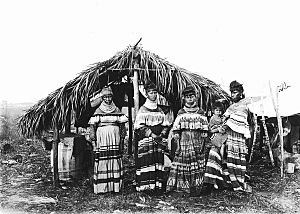
The few hundred Seminoles who stayed in Florida survived in the swamps. They avoided being removed. They lived in the Everglades to keep away from European Americans. Seminoles continued their unique way of life, like living in "clan-based matrilocal residence in scattered thatched-roof chickee camps." Today, the Florida Seminoles are proud that their ancestors were never defeated.
In the 1900s, before World War II, the Florida Seminoles split into two groups. One group was more traditional. The other was willing to adapt to reservations. Those who accepted reservation lands and adapted were recognized by the federal government in 1957 as the Seminole Tribe of Florida.
Many of those who kept their traditional ways and spoke the Mikasuki language formed a separate government. They were recognized as the Miccosukee Tribe of Indians of Florida. They got state recognition in 1957 and federal recognition in 1962. Other Seminoles who are not part of these recognized groups are called Traditional or Independent Seminole.
When the tribes were recognized in 1957 and 1962, they made agreements with the U.S. government. These agreements confirmed their right to govern their own tribal lands.
Seminole Tribe of Florida
The Seminoles worked hard to adapt. But they were greatly affected by the fast-changing American environment. Natural disasters and government projects to drain the Everglades caused many changes. New homes, farms, and businesses changed the Seminoles' natural, social, political, and economic world. In the 1930s, Seminoles slowly started to move onto government-assigned reservation lands. The U.S. government bought lands and held them for Seminole use. At first, few Seminoles wanted to move to reservations or work with the government. Some feared they would be forced to move to Oklahoma. Others accepted the move hoping for stability, jobs promised by the Indian New Deal, or because they became Christian.
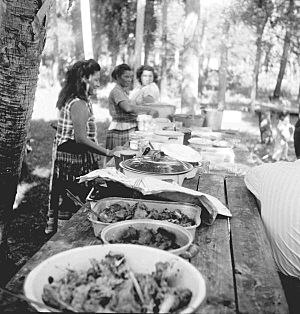
Starting in the 1940s, more Seminoles moved to the reservations. A big reason for this was that many Seminoles became Christian. This happened after a Creek Baptist evangelist named Stanley Smith started missionary work. For the new converts, moving to the reservations allowed them to build their own churches. There, they mixed their traditions into their Christian practices. Reservation Seminoles began forming tribal governments and working with the Bureau of Indian Affairs. In 1957, the nation reorganized and officially worked with the U.S. government as the Seminole Tribe of Florida. The Seminole Tribe of Florida has its main office in Hollywood, Florida. They control several reservations: Big Cypress, Brighton Reservation, Fort Pierce Reservation, Hollywood Reservation, Immokalee Reservation, and Tampa Reservation.
Miccosukee Tribe of Indians of Florida
A traditional group, known as the Trail Indians, moved their camps closer to the Tamiami Trail. This road connected Tampa and Miami. There, they could sell crafts to travelers. They felt left out when other Seminoles moved to reservations. They felt those Seminoles were adopting too many European American ways. Their differences grew in 1950 when some reservation Seminoles filed a land claim lawsuit against the government. The Trail Indians did not support this action.
After the Seminole Tribe of Florida was recognized in 1957, the Trail Indians decided to form their own government. They sought recognition as the Miccosukee Tribe because they spoke the Mikasuki language. This language was not understood by Creek speakers. But some members of each group could speak both languages.
The Miccosukee Tribe of Indians of Florida received federal recognition in 1962. The federal government gave them their own reservation lands, called the Miccosukee Indian Reservation. The Miccosukee Tribe set up a 333-acre reservation on the northern edge of Everglades National Park. It is about 45 miles west of Miami.
Seminole Economy and Commerce
In the 2000 U.S. census, 12,431 people said they were Seminole American. Another 15,000 people identified as Seminole mixed with another tribe or race.
The Seminoles in Florida have been raising cattle since the mid-1930s. They received cattle from western Native Americans. The Bureau of Indian Affairs (BIA) hoped that cattle raising would help Seminoles become citizens by adapting to farming life. The BIA also hoped this program would help Seminoles become self-sufficient. Cattle owners realized they could use their cattle as a way to get money for "new capital-intensive pursuits," like housing.
Since then, the two Florida tribes have built economies based on selling duty-free tobacco, tourism, and gaming. On December 7, 2006, the Seminole Tribe of Florida bought the Hard Rock Cafe chain of restaurants. They had already licensed it for some of their casinos.
Starting in the 1930s during the Great Depression, the Seminole Tribe of Florida now owns "one of the largest cattle operations in Florida." It is the 12th largest in the nation.
In the early 1900s, Florida's population grew quickly after the Flagler railroad reached Miami. The state attracted many tourists from the North and Midwest. This helped many resort towns grow. In the following years, many Seminoles took jobs in tourism. They also sold traditional craft products, mostly made by women. Men showed traditional skills, like wrestling alligators. Some crafts included woodcarving, basket weaving, beadworking, patchwork, and making palmetto dolls. These crafts are still practiced today.
In the 21st century, gaming has become very profitable for the tribes. Fewer Seminoles now rely on crafts for money. The Miccosukee Tribe earns money by owning and running a casino, a resort, a golf club, museums, and an "Indian Village." At "Indian Village," Miccosukee people show traditional ways of life to teach others about their culture.
In 1979, the Seminoles opened the first casino on Native American land. This started a multi-billion-dollar industry run by many tribes across the country. This casino was the first tribal bingo hall in North America. Since then, gaming on Native American land has grown. It is now a major source of income for tribal governments. Tribal gaming has provided steady jobs. The money has supported higher education, health insurance, services for elders, and personal income. In recent years, money from gaming has funded big economic projects. These include buying and developing sugarcane fields, citrus groves, cattle ranches, ecotourism, and commercial farming.
Many places in Florida are named after the Seminole:
- Seminole County;
- Osceola County;
- Seminole, a city in Pinellas County;
- Seminole, a small community in Okaloosa County.
- Historic Seminole Heights, a neighborhood in Tampa, Florida.
There is also a Seminole County in Oklahoma, and a Seminole County in southwest Georgia.
See also
 In Spanish: Semínola para niños
In Spanish: Semínola para niños
- Seminole (clipper), an 1865 clipper ship
- Florida State Seminoles, athletic teams of Florida State University


